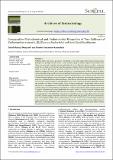| dc.contributor.author | David Mutisya Musyimi, Marble Namarobe Namnabah | |
| dc.date.accessioned | 2022-01-22T07:53:20Z | |
| dc.date.available | 2022-01-22T07:53:20Z | |
| dc.date.issued | 2021 | |
| dc.identifier.uri | https://repository.maseno.ac.ke/handle/123456789/4495 | |
| dc.description | Journal homepage: https://office.scicell.org/index.php/AE | en_US |
| dc.description.abstract | Medicinal plants have served as sources of medicine to treat and suppress the diseases, because many
pathogens are gaining resistance to the current synthetic drugs. In addition, high cost and adverse side
effects are commonly associated with popular Synthetic drugs. Therefore, there is need for continuous
search for new drugs in order to overcome this emerging resistance. Plants synthesize bioactive compounds
which are of great potential in agriculture, antimicrobial and anti-insect activity. The concentration of
bioactive compounds in each plant species depends on the environmental conditions, age of the plant,
relative humidity of harvested materials and method of extraction. Little is known on the phytochemical
and antimicrobial potential of Alba and Rosea cultivars of Catharanthus roseus ethanol extracts. The leaves
of Alba and Rosea cultivars were investigated for their phytochemical and antimicrobial properties. The
study was conducted at Maseno University, Kenya. Plant Leaves were collected around Maseno University.
Leaves of Alba and Rosea cultivars of Catharanthus roseus were air-dried in the shade, thereafter crushed
into powder and ethanol extraction done using the Rotary evaporator. Antimicrobial activity of the
pathogenic microorganisms was Candida albicans and Escherichia coli. The paper disc diffusion method was
used for antimicrobial tests. Different concentrations of ethanol leaf extracts which consisted of 2.5, 5and
7.5 mg/mL with three replications. Sterile water was used a control. The data on growth inhibition were
subjected to analysis of variance (ANOVA) using SAS statistical package. Treatment means were separated
and compared at p = 0.05. Phytochemical analysis revealed the presence of tannins, flavonoids, terpenoids,
saponins, alkaloids and phenols in the leaf extract except steroids and glycosides. The ethanol leaf extracts
were active against Candida albicans and Escherichia coli. Alba leaves extracts showed higher inhibitory
zones compared to Rosea leaves. The observed differences in antimicrobial activity could be due to
differences in cell wall synthesis, structure and composition. The results of present study further confirm
the use of these plants traditionally for the treatment of different ailments | en_US |
| dc.publisher | Archives of Ecotoxicology | en_US |
| dc.subject | Pathogenic microorganisms, growth inhibition, ethanol extraction, secondary metabolites, leaves | en_US |
| dc.title | Archives of Ecotoxicology | en_US |
| dc.type | Article | en_US |

